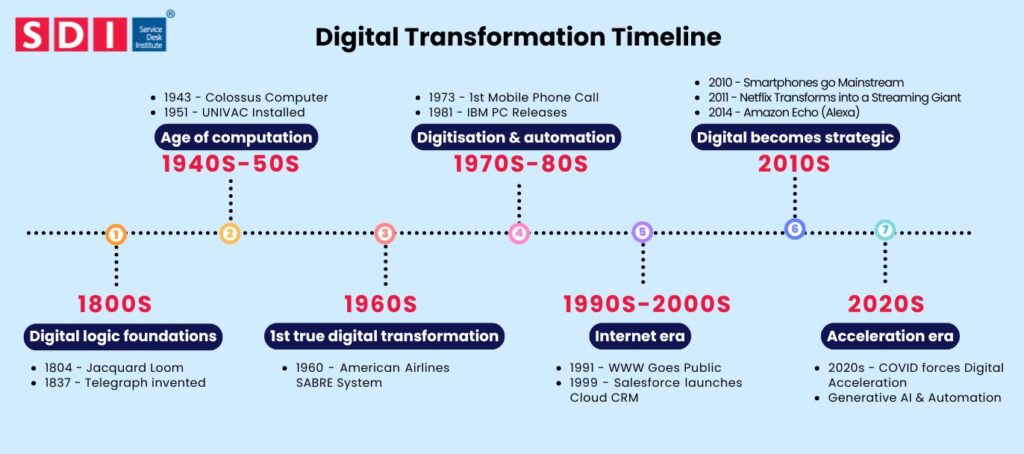 Back to Resources
Back to Resources
About the Author
John Noctor, SDI’s Chief Customer Success Officer

Dedicated to driving customer success and delivering exceptional customer experiences, John is an evangelist for continual improvement, well known for his broad range of Service Management capabilities. As well as a wealth of knowledge (stretching over 25 years) in ITSM tools, implementations and service transformation, John is the SDI’s Chief Delivery Officer and a key contributor to SDI’s Professional Standards for Service Desk Professionals.
Digital Transformation vs. Digital Enablement
Since I first stepped into the world of IT in 1988, the phrase Digital Transformation has been a constant companion, cropping up in different contexts, industries, and interpretations. These days, it’s a buzzword, sure. But it’s also a powerful idea with roots that go deeper than most people realise.
We tend to jump straight to the cloud, AI, or customer apps when we hear “digital transformation.” But this concept goes back decades, and the first real example might surprise you.
Let’s Rewind to the 1960s: Enter SABRE
To find the first true digital transformation — not just automation, but a complete rethink of how a business runs — we have to hop on a flight back to the 1960s.
American Airlines, in partnership with IBM, developed the SABRE system (short for Semi-Automated Business Research Environment). Before SABRE, booking a flight was a manual slog. SABRE changed everything, turning that process into a near-instant operation using real-time data and massive mainframes.
It wasn’t just a system upgrade. It was a full-on business reinvention. That’s what digital transformation is all about: not doing the same things faster, but doing new things in new ways — powered by tech.
A Few “Proto-Digital” Firsts
- 1804 – The Jacquard Loom used punch cards to automate weaving patterns. Early digital logic? You bet.
- 1837 – The Telegraph digitised long-distance communication before the internet was even a glimmer in anyone’s eye.
But when we’re talking about business being reshaped by digital capability? SABRE still takes the crown. In fact, to put this into perspective, let us take a look at a timeline for Digital Transformation!

My First Digital Transformation: The Casio Watch
Let’s bring it back to the 1980s. My personal digital transformation moment? A Casio digital watch, gifted to me for my 12th birthday. (I like to think of it as a proto–Internet of Things device.)
That tiny screen opened a whole new world. I could time how long it took to walk to school! I started to feel what digital experience could do — not just functionally, but emotionally. That watch also taught me my first lesson in digital resilience… when I forgot to take it off before a bath. Rest in peace, little Casio. My mum was not impressed.
But that story stuck with me. Even back then, I sensed something important:
If we focus only on digital transformation, without digital enablement, we’re setting ourselves up for digital friction and poor experiences.
Cars of the Future, Drivers from the Past?
Let’s switch gears. A few years ago, I watched a Formula 1 race engineer talk about the evolution of technology in motorsport. He said something that really landed with me:
“You could probably jump into an F1 car from the 1960s and drive it around a track. Try that with a modern F1 car? You might not even get it started.”
Today’s F1 steering wheels look like something out of Star Trek — buttons, switches, readouts everywhere. To an “un-enabled” driver, it’s overwhelming. But to one who’s been trained and enabled? That wheel is a control hub for making fast, strategic decisions at 200mph.
And that’s the point: Enablement is what turns complexity into capability.
Human Dynamics of Change
Digital transformation isn’t just a tech project. It’s a people journey. If we don’t bring our stakeholders along — teaching, listening, enabling — we risk ending up with beautifully designed systems that no one really uses, or worse, actively resents.
So here’s how I think about it:
Start with Enablement. Implement Transformation. End with Experience.
It’s like a sandwich:
🍞 Enablement is the bread.
🥪 Transformation is the filling.
🍞 Experience brings it all together.
What Does Digital Enablement Look Like?
- Work with stakeholders to understand what they’re really trying to achieve (hint: use models like MoSCoW for prioritisation).
- Define and publish a digital enablement strategy.
- Treat Workforce Digital Experience (WDEX) as a priority in its own right.
- Make sure your Voice of the Customer (VoC) program includes digital experiences.
- Design feedback loops to capture and eliminate digital friction.
- Don’t just ask, “What does good look like?” — ask, “What does success feel like?”
Wrapping Up
When you’re talking to stakeholders about digital transformation and enablement, I recommend starting with these three questions:
- Why are we transforming? (Enablement)
- Where are we going? (Enablement + Transformation)
- How will we get there? (Transformation)
And remember:
“Transformation means we can run; enablement lets us fly.”
Finally, Digital Enablement was a key feature we wanted to incorporate into the new Service Desk Certification (SDC) version 9.
To find out more, please click the link or the image below!













